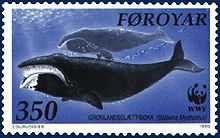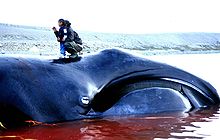- Bowhead whale
-
Bowhead whale[1] 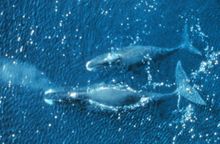

Size comparison against an average human Conservation status Scientific classification Kingdom: Animalia Phylum: Chordata Class: Mammalia Order: Cetacea Suborder: Mysticeti Family: Balaenidae Genus: Balaena
Linnaeus, 1758Species: B. mysticetus Binomial name Balaena mysticetus
Linnaeus, 1758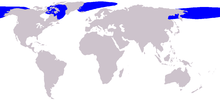
Bowhead whale range The bowhead whale (Balaena mysticetus) is a baleen whale of the right whale family Balaenidae in suborder Mysticeti. A stocky dark-colored whale without a dorsal fin, it can grow to 20 m (66 ft) in length. This thick-bodied species can weigh 75 tonnes (74 long tons; 83 short tons) to 100 tonnes (98 long tons; 110 short tons),[3] second only to the blue whale, although the bowhead's maximum length is less than several other whales. It lives entirely in fertile Arctic and sub-Arctic waters, unlike other whales that migrate to feed or reproduce. It is also known as Greenland right whale or Arctic whale. American whalemen called it the "Steeple-top" or "Polar whale".[4] The bowhead is perhaps the longest-living mammal, and has the largest mouth of any animal.[5]
The bowhead was an early whaling target. Its population was severely reduced before a 1966 moratorium. The population is estimated to be over 24,900 worldwide, down from an estimated 50,000 before whaling.
Contents
Taxonomy
See also: Evolution of cetaceansCarl Linnaeus described the bowhead whale in the 10th edition of his Systema Naturae (1758).[6]
The bowhead whale currently occupies a monotypic genus, separate from the other right whales, as it has done since the work of Gray in 1821. Little genetic evidence supports this two-genera categorization. Indeed, the members of Balaenoptera show greater differences than do the bowhead and the right whales. All four species will likely be placed in one genus in some future review.[7]
It is thought Balaena prisca, one of the five Balaena fossils from the late Miocene (~10 Mya) to early Pleistocene (~1.5 Mya), may be the same as the modern bowhead whale. The earlier fossil record shows no related cetacean after Morenocetus, found in a South American deposit dating back 23 million years.
Description
The bowhead whale has a robust, dark-colored body, no dorsal fin and a strongly bowed lower jaw and narrow upper jaw. Its baleen, the longest of any whale at 3 m (9.8 ft), strains tiny prey from the water. The whale has a massive bony skull which it uses to break through the Arctic ice to breathe. Inuit hunters have reported them surfacing through 60 cm (24 in) of ice. The bowhead may reach up to 20 m (66 ft). The largest yet reported was 21.2 m (70 ft) m for an unweighed giant caught off Spitsbergen, Norway.[8] Females are larger than males. Its blubber is the thickest of any animal, averaging 43–50 cm (17–20 in).
Life history
The bowhead is social and nonaggressive, and retreats under the ice when threatened.
Swimming
The bowhead is a slow swimmer and usually travels alone or in small herds of up to six. Though it may remain submerged as long as 40 minutes in a single dive, it is not thought to be a deep diver.
The whales' behavior can also include breaching, tail slapping, and spyhopping.
Vocalizations
The bowhead whale is highly vocal, and uses underwater sounds to communicate while traveling, feeding, and socializing. Some bowheads make long repetitive songs that may be mating calls.
Reproduction
Sexual activity occurs between pairs and in boisterous groups of several males and one or two females.
Breeding has been observed from March through August; conception is believed to occur primarily in March. Reproduction can begin when a whale is 10 to 15 years old. Females produce a calf once every 3 to 4 years, after a 13–14 month pregnancy. The newborn calf is about 4.5 m (15 ft) long and approximately 1,000 kg (2,200 lb), growing to 9 m (30 ft) by its first birthday.
Because of their long lifespans, females are believed to go through menopause. Observations of very large animals without calves support this hypothesis.[9]
Lifespan
Bowheads were once thought to live 60 to 70 years, similar to other whales. However, discoveries of 19th century ivory, slate, and jade spear points in freshly killed whales in 1993, 1995, 1999, and 2007[10] triggered research based on structures in the whale's eye, suggesting at least some individuals reached 150–200 years old (another report claimed a 90 year old female was still fertile).[11] The amino acid racemization process has provided the scientific basis for these claims. This process is controversial and has failed to correlate well with other dating methods.[12]
In May 2007, a 50 tonnes (49 long tons; 55 short tons) specimen caught off the Alaskan coast was discovered with the head of an explosive harpoon embedded deep under its neck blubber. The 3.5 inches (89 mm) arrow-shaped projectile was manufactured in New Bedford, Massachusetts, a major whaling center, around 1890, suggesting the animal may have survived a similar hunt more than a century ago.[13][14][15]
Ecology
Population
The bowhead population around Alaska has increased since commercial whaling ceased. Alaska Natives continue to kill small numbers in subsistence hunts each year. This level of killing (25–40 animals annually) is not expected to affect the population's recovery. The population off Alaska's coast (the "Bering-Chukchi-Beaufort stock") appears to be recovering and was about 10,500 animals as of 2001. Researchers from the School of Fisheries and Ocean Sciences have been studying the whales feeding behavior in the Point Barrow area. The status of other populations is less well known. There were about 1,200 off West Greenland in 2006, while the Svalbard population may only number in the tens.
In March, 2008, Canada's Department of Fisheries and Oceans stated that previous estimates in the Eastern Arctic had undercounted, with a new estimate of 14,400 animals (r. 4,800–43,000).[16] These larger numbers correspond to pre-whaling estimates, indicating this population has fully recovered. However, should climate change substantially shrink sea ice, they could be threatened by increased shipping traffic.[17]
Range and habitat
The bowhead whale is the only baleen whale that spends its entire life in and around Arctic waters. The Alaskan population spends the winter months in the southwestern Bering Sea. The group migrates northward in the spring, following openings in the pack ice, into the Chukchi and Beaufort seas.
Feeding
Unlike most other baleen whales which primarily feed on concentrated shoals of prey species, it feeds in a manner similar to the basking shark by swimming forward with its mouth wide open, continuously filtering water through its baleen plates. Thus, it specializes in much smaller prey, such as copepods. Its mouth has a large upturning lip on the lower jaw that helps to reinforce and contain the baleen plates within its mouth, and prevents buckling or breakage of the plates due to the pressure of the water passing through them as it advances.
This is in contrast to the rorquals, which have distendable ventral pleats that they fill with prey-laden water, then expel the water while filtering out the prey through their baleen plates.
Predation
The principal predators of bowheads are humans. Occasionally, predatory attacks by orca pods have also been recorded.[18]
Whaling
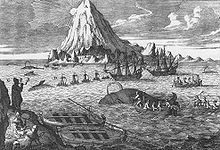 Eighteenth century engraving showing Dutch whalers hunting bowhead whales in the Arctic
Eighteenth century engraving showing Dutch whalers hunting bowhead whales in the Arctic
The bowhead whale has been hunted for blubber, meat, oil, bones, and baleen. Like right whales, it swims slowly, and floats after death, making it ideal for whaling. Before commercial whaling, there were an estimated 50,000 bowheads.[citation needed]
Commercial bowhead whaling began in the 16th century, when the Basques killed them as they migrated south through the Strait of Belle Isle in the fall and early winter. In 1611, the first whaling expedition sailed to Spitsbergen. By mid-century, the population(s) there had practically been wiped out, forcing whalers to voyage into the "West Ice"—the pack ice off Greenland's east coast. By 1719, they had reached the Davis Strait, and by the first quarter of the 19th century, Baffin Bay. In the North Pacific, commercial bowhead whaling began in the 1840s, and within two decades wiped out over 60 percent of the bowheads.
Commercial whaling, the principal cause of the population decline, is over. Bowhead whales are now hunted on a subsistence level by native peoples of North America.
Conservation
The bowhead is listed in Appendix I by CITES (that is, "threatened with extinction"). It is listed by the National Marine Fisheries Service as "endangered" under the auspices of the United States' Endangered Species Act. The IUCN Red List data are as follows:
- Svalbard population – Critically endangered
- Sea of Okhotsk subpopulation – Endangered
- Baffin Bay-Davis Strait stock – Endangered
- Hudson Bay-Foxe Basin stock – Vulnerable
- Bering-Chukchi-Beaufort stock – Lower risk – conservation dependent
The Bowhead whale is listed on Appendix I[19] of the Convention on the Conservation of Migratory Species of Wild Animals (CMS) as this species has been categorized as being in danger of extinction throughout all or a significant proportion of their range and CMS Parties strive towards strictly protecting these animals, conserving or restoring the places where they live, mitigating obstacles to migration and controlling other factors that might endanger them.
See also
References
- ^ Mead, James G.; Brownell, Robert L., Jr. (16 November 2005). "Order Cetacea (pp. 723-743)". In Wilson, Don E., and Reeder, DeeAnn M., eds. Mammal Species of the World: A Taxonomic and Geographic Reference (3rd ed.). Baltimore: Johns Hopkins University Press, 2 vols. (2142 pp.). ISBN 978-0-8018-8221-0. OCLC 62265494. http://www.bucknell.edu/msw3/browse.asp?id=14300005.
- ^ Reilly, S.B., Bannister, J.L., Best, P.B., Brown, M., Brownell Jr., R.L., Butterworth, D.S., Clapham, P.J., Cooke, J., Donovan, G.P., Urbán, J. & Zerbini, A.N. (2008). Balaena mysticetus. In: IUCN 2008. IUCN Red List of Threatened Species. Downloaded on 2009-01-31.
- ^ Rugh, David J. and Kim E.W. Shelden (2008). "Bowhead Whale". In Perrin, W.; Wursig, B. and Thewissen, J.. Encyclopedia of Marine Mammals. Academic Press. p. 131.
- ^ Scammon (1874).
- ^ Guinness World Records (2007-11-14). "Whale of a time!". Guinness World Records. http://www.guinnessworldrecords.com/news/2007/11/071114.aspx. Retrieved 2009-06-04.
- ^ (Latin) Linnaeus, C (1758). Systema naturae per regna tria naturae, secundum classes, ordines, genera, species, cum characteribus, differentiis, synonymis, locis. Tomus I. Editio decima, reformata.. Holmiae. (Laurentii Salvii).. p. 824. http://dz1.gdz-cms.de/index.php?id=img&no_cache=1&IDDOC=265100.
- ^ Kenney, Robert D. (2002). "North Atlantic, North Pacific and Southern Right Whales". In William F. Perrin, Bernd Wursig and J. G. M. Thewissen. The Encyclopedia of Marine Mammals. Academic Press. pp. 806–813. ISBN 0-12-551340-2.
- ^ Wood (1983). The Guinness Book of Animal Facts and Feats. Sterling Pub Co Inc. ISBN 978-0851122359.
- ^ Rare Whales Can Live to Nearly 200, Eye Tissue Reveals. News.nationalgeographic.com (2010-10-28). Retrieved on 2011-09-15.
- ^ Eskimo Heritage Program Subsistence in Alaska Timeline. Kawerak.org. Retrieved on 2011-09-15.
- ^ Bowhead Whales May Be the World's Oldest Mammals. Gi.alaska.edu (2001-02-15). Retrieved on 2011-09-15.
- ^ Amino Acid Racemization. Pubs.acs.org. Retrieved on 2011-09-15.
- ^ John C. George, Jeffrey Bada, Judith Zeh, Laura Scott, Stephen E. Brown, Todd O'Hara, and Robert Suydam (1999). "Age and growth estimates of bowhead whales (Balaena mysticetus) via aspartic acid racemization". Can. J. Zool. 77 (4): 571–580. doi:10.1139/cjz-77-4-571.
- ^ Conroy, Erin. (2007-12-06) Netted whale hit by lance a century ago – Science – MSNBC.com. MSNBC. Retrieved on 2011-09-15.
- ^ 19th-century weapon found in whale » Propeller[dead link]
- ^ Eastern Arctic bowhead whales not threatened. Cbc.ca (2008-04-16). Retrieved on 2011-09-15.
- ^ Laidre, Kristin. "Foraging Ecology of Bowhead Whales in West Greenland." Monster Jam. Northwest Fisheries Science Center, Seattle. 22 January 2009.
- ^ Bowhead Whale. The Kids’ Times: Volume II, Issue 2. NOAA’s National Marine Fisheries Service, Office of Protected Resources (2011)
- ^ "Appendix I" of the Convention on the Conservation of Migratory Species of Wild Animals (CMS). As amended by the Conference of the Parties in 1985, 1988, 1991, 1994, 1997, 1999, 2002, 2005 and 2008. Effective: 5th March 2009.
External links
- US National Marine Fisheries Service bowhead whale web page
- ARKive – images and movies of the bowhead whale (Balaena mysticetus)
- Bowhead Whale: Detailed Information from NOAA
- Harpoon may prove whale was at least 115 years old
- Eastern Arctic bowhead whales not threatened
- Watch the documentary, In Search of the Bowhead Whale
- World Wide Fund for Nature (WWF) – species profile for Bowhead whale
- In Search of the Bowhead Whale (on NFB.ca) A documentary by Bill Mason from 1974 following an expedition that searches out and meets the bowhead and beluga.
Categories:- IUCN Red List least concern species
- Arctic cetaceans
- Balaenidae
- Alaska culture
- Megafauna of Eurasia
- Megafauna of North America
- Monotypic mammal genera
- Greenlandic cuisine
- Animals described in 1758
Wikimedia Foundation. 2010.



